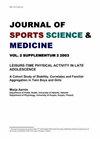Estimating Active Drag Based on Full and Semi-Tethered Swimming Tests
IF 2.4
2区 医学
Q2 SPORT SCIENCES
引用次数: 0
Abstract
During full tethered swimming no hydrodynamic resistance is generated (since v = 0) and all the swimmer’s propulsive force (FP) is utilized to exert force on the tether (FT = FP). During semi-tethered swimming FP can be made useful to one of two ends: exerting force on the tether (FST) or overcoming drag in the water (active drag: Da). At constant stroke rate, the mean propulsive force (FP) is constant and the quantity FP - FST (the “residual thrust”) corresponds to Da. In this study we explored the possibility to estimate Da based on this method (“residual thrust method”) and we compared these values with passive drag values (Dp) and with values of active drag estimated by means of the “planimetric method”. Based on data obtained from resisted swimming (full and semi-tethered tests at 100% and 35, 50, 60, 75, 85% of the individual FT), active drag was calculated as: DaST = kaST .vST2 = FP - FST (“residual thrust method”). Passive drag (Dp) was calculated based on data obtained from passive towing tests and active drag (“planimetric method”) was estimated as: DaPL = Dp.1.5. Speed-specific drag (k = D/v2) in passive conditions (kp) was )25 kg.m-1 and in active conditions (ka) )38 kg.m-1 (with either method); thus, DaST > Dp and DaST > DaPL. In human swimming active drag is, thus, about 1.5 times larger than passive drag. These experiments can be conducted in an ecological setting (in the swimming pool) by using basic instrumentation and a simple set of calculations.根据全系和半系游泳测试估算主动阻力
在完全系留游泳过程中,不会产生水动力阻力(因为 v = 0),游泳者的所有推进力(FP)都被用来对系留施力(FT = FP)。在半系留游泳过程中,FP 可用于两个目的之一:对系留施力(FST)或克服水中阻力(主动阻力:Da)。在恒定的划水速度下,平均推进力(FP)是恒定的,FP - FST("剩余推力")相当于 Da。在这项研究中,我们探讨了根据这种方法("剩余推力法")估算 Da 值的可能性,并将这些值与被动阻力值(Dp)以及通过 "平面测量法 "估算的主动阻力值进行了比较。根据阻力游泳获得的数据(在 100%和 35、50、60、75、85%的单个 FT 条件下进行的完全和半系留测试),主动阻力的计算公式为DaST = kaST .vST2 = FP - FST("剩余推力法")。被动阻力(Dp)根据被动拖曳试验获得的数据计算,主动阻力("平面法")按以下公式估算:DaPL = Dp.1.5。被动条件下的特定速度阻力(k = D/v2)(kp)为)25 kg.m-1,主动条件下的特定速度阻力(ka)为)38 kg.m-1(任一方法);因此,DaST > Dp,DaST > DaPL。因此,在人类游泳中,主动阻力大约是被动阻力的 1.5 倍。通过使用基本仪器和一套简单的计算,这些实验可以在生态环境(游泳池)中进行。
本文章由计算机程序翻译,如有差异,请以英文原文为准。
求助全文
约1分钟内获得全文
求助全文
来源期刊
CiteScore
5.60
自引率
6.20%
发文量
56
审稿时长
4-8 weeks
期刊介绍:
The Journal of Sports Science and Medicine (JSSM) is a non-profit making scientific electronic journal, publishing research and review articles, together with case studies, in the fields of sports medicine and the exercise sciences. JSSM is published quarterly in March, June, September and December. JSSM also publishes editorials, a "letter to the editor" section, abstracts from international and national congresses, panel meetings, conferences and symposia, and can function as an open discussion forum on significant issues of current interest.

 求助内容:
求助内容: 应助结果提醒方式:
应助结果提醒方式:


